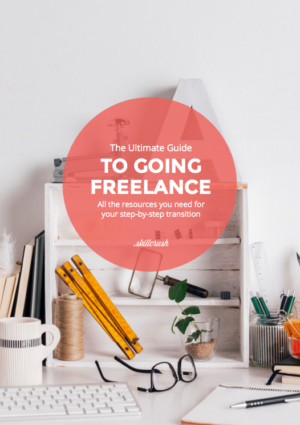
Get Your FREE Guide to Going Freelance
All the resources you need to transition into full-time freelance!
As a self-proclaimed non-fiction literature junkie and freelance marketer, I wanted to share my knowledge with other aspiring freelancers, who may not have the time or the drive to put together a reading list at the end of a long day. If you’re just getting started with that freelance life, you should jump in with one of my favorite freelancing how-to tomes, so that you can get started on a smarter, more efficient path to career success.
The book in question is Book Yourself Solid: The Fastest, Easiest, and Most Reliable System for Getting More Clients Than You Can Handle Even if You Hate Marketing and Selling by Michael Port.
To start a business, all you need is one client. And this book sets you on your way by helping you refine the answers to questions you’ll get asked all the time on your hunt for paying customers.
The questions might seem simple—along the lines of: who are you, and what do you do, and you may think you know the answers. But, are you delivering them in the most client-friendly way? My guess is no—because the most client-friendly way isn’t intuitive, and when I was first starting out, I got it all wrong.
Reasons to Read
Read this book if you’re looking for direct ways to improve your business skills and grow your freelance business, and if you enjoy hands-on methods of learning. This book doesn’t fall into the self-help category so much as it does implementation—or even planning. For example, Port includes a ton about prepping for conversations and situations where you’ll be called to market yourself. Port also forces you to treat yourself like a professional, because if you don’t, who will? He takes it a step further by encouraging you to treat your own work like you treat your client’s—and your client’s well-being should be of the utmost importance. Learning this mindset will give you a critical leg up with your freelance business.
In a Nutshell
This book makes a great starting point for a freelancer (despite some of the later chapters being a bit dated for the social media we now use in 2017) because it offers super simple, concrete tasks that you can do to improve your ability to lock down clients right now.
One of the simple truths that you’ll learn as you grow into your career is that there are many people who desperately need your skills right now. When you can convey that what you do solves their pain point, you’ll see more interest in your services—even when you’re talking to people who don’t need your help. Business owners talk to each other about their problems, and that’s how word spreads.
Book Yourself Solid will help you understand how to clearly and correctly pitch yourself and your services. Unlike other business improvement or professional development books, this one doesn’t use generalizations. Port gets down to brass tacks and gives readers tasks that will help you communicate your worth and skill set to clients.
It might initially feel silly to do the tasks Port prescribes because you’ll end up writing things down that you feel like you may already know about your business or goals as a freelancer. For example, what would you say if asked: “Tell me what you do.”
Is your answer short, clear, interesting, and accurate? Once you sit down to write, you’ll find it’s surprisingly difficult to nail down specific, bite-sized pieces of information about who you are and what exactly you do, professionally—especially in clear, easy-to-communicate ways. The exercises in the book force you to confront these issues in concrete terms.
Take my own self-marketing, for example. When I say “I’m a marketing consultant,” people tend to back away slowly because that’s both boring and meaningless. But after reading Book Yourself Solid and trying out the assigned tasks, I say “I fix broken marketing programs for growing companies.” People perk up and think: “Oh! my marketing sucks and I want to grow—this must be for me!”
The Best Chapters
Really, anything in chapters 1-4 is worth a read, because the exercises apply to anyone in a service-based business (everything from design to development to creative services—all freelancers can benefit from this). The information in the second half of the first edition of the book, about blogs and social media, can be a bit outdated since it was written in 2010. But I’ve found that Port’s advice about self-promotion and branding is evergreen in that it revolves around self-understanding and basic communication skills.
The Critical Takeaway
One of my favorite takeaways from this book is the concept of what Port calls the “Red Velvet Rope Policy”. Basically, he’s giving permission to recognize that sometimes it’s not the right time to work with someone. Saying no helps both you and the potential client use your time in a more productive manner because you aren’t wasting it on each other. Clients are guilty of hiring at the wrong time just as much as freelancers/consultants are of closing at the wrong time. Since most freelance work (and work in general) comes from referrals and word of mouth in this model, doesn’t it make more sense to focus on what course of action gives you both the best chances of success? Even though it seems counter-intuitive in the moment to turn down a client, it’s better business in the long run to protect your chances of future work, and your reputation in their network, by putting up your own metaphorical velvet rope.

Get Your FREE Guide to Going Freelance
All the resources you need to transition into full-time freelance!
